From 23 October 2019 to 16 February 2020, the Städel Museum is devoting an extensive exhibition to the painter Vincent van Gogh (1853–1890). It focuses on the creation of the “legend of Van Gogh” around 1900 as well as his significance to modern art in Germany. Featuring 50 of his key works, it is the most comprehensive presentation in Germany to include works by the painter for nearly 20 years. MAKING VAN GOGH addresses the special role that gallery owners, museums, private collectors and art critics played in Germany in the early twentieth century for the posthumous reception of Van Gogh as the “father of modern art”. Just less than 15 years after his death, in this country Van Gogh was perceived as one of the most important precursor of modern painting. Van Gogh’s life and work attracted broad and lasting public interest. His art was collected in Germany unusually early. By 1914 there was an enormous number of works by Van Gogh, around 150 in total, in private and public German collections. At the same time, German artists began to vigorously examine his works. Van Gogh’s painting became a model and a substantial source of inspiration in particular for the young Expressionists. The emergence of modernism in Germany is hardly conceivable without his art.
Van
Gogh’s success story is closely connected with the Städel. With the
support of the Städelscher Museums-Verein, in 1908 it was one of the
first museums to purchase works by the Dutch artist for assembling a
modern art collection: the painting
 Farmhouse in Nuenen (1885) 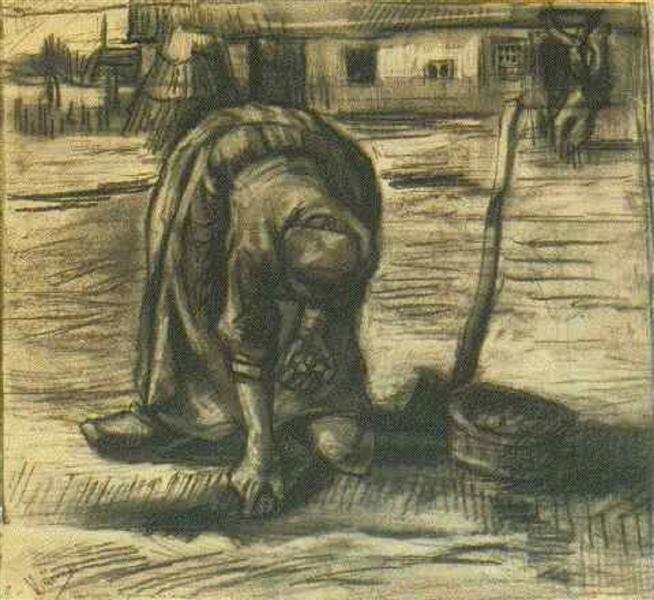 and the drawing Peasant Woman Planting Potatoes (1885).  Three years later, the Portrait of Dr Gachet (1890), one of Van Gogh’s most famous paintings, was bought for the museum’s collection. In three comprehensive chapters, the exhibition deals with the development and impact of the “legend of Van Gogh” in Germany. How did it come about that Van Gogh became so popular especially in Germany? Who championed his oeuvre, and how did artists respond to it? The exhibition presents Van Gogh as a pivotal figure for art of the German avant-garde. It makes an important contribution to understand the development of art in Germany at the beginning of the twentieth century. The Städel unites more than 120 paintings and works on paper in the exhibition. 50 key works by Vincent van Gogh from all of his creative phases constitute the core of the exhibition. On view are outstanding loans from private collections and leading museums world-wide. 70 works by German artists exemplify Van Gogh’s influence and impact on the subsequent generation. These include works by well-known artists such as Max Beckmann, Ernst Ludwig Kirchner, Alexej von Jawlensky, Paula Modersohn-Becker or Gabriele Münter as well as by others whose artistic positions could be rediscovered, including Peter August Böckstiegel, Theo von Brockhusen, Heinrich Nauen or Elsa Tischner-von Durant. “Whereas today the enthusiasm for Vincent van Gogh may be an almost global phenomenon, more than 100 years ago things still looked very different. Our exhibition throws light on the role that Van Gogh’s reception in early-twentieth-century Germany played in the creation of the “legend of Van Gogh”. Initially, it was primarily thanks to the activities of his sister-in-law Johanna van Gogh-Bonger that the artist did not disappear into oblivion after his early death. However, soon it was especially gallery owners, artists, collectors and museum directors in Germany, many of them of Jewish origin, who became interested in Van Gogh’s painting and ultimately defended it against nationalist tendencies and political instrumentalization”, remarks Philipp Demandt, the director of the Städel Museum. Sylvia von Metzler, President of the Städelscher Museums-Verein, says about the exhibition: “When the Städelscher Museums-Verein acquired the first works by Vincent van Gogh for the Städel Museum in 1908, this was a courageous and trailblazing decision. Until today both works are still a permanent feature of the museum’s holdings. Without the town’s progressive collector figures, its citizenry and the typical openness with which Frankfurters embraced new artistic currents, the Städel would not have become what it is today. We are delighted that we can now, even more than 100 years later, support this major exhibition devoted to Vincent van Gogh.” “Shortly after his death, Vincent van Gogh became an ‘artist’s artist’, a benchmark for representatives of his profession. However, the public at large thought his art was outlandish, as it could hardly be gauged according to traditional standards. This changed in the early days of the twentieth century concurrent with the Expressionist movements in Germany. Soon after encountering Van Gogh’s works in publications and exhibitions, artists cultivated a particularly intimate relationship with their idol. They orientated themselves towards his impasto application of colour, rhythmic brushwork, rich colour contrast, bold compositions and motifs, as well as his ornamentally vibrant drawings. At the same time, his personal perception of nature and its anti-academic representation played a crucial role”, explains Alexander Eiling, Head of Modern Art, Städel Museum, and curator of the exhibition. “German art history of the twentieth century would have proceeded completely differently without Van Gogh. Artists’ groups such as ‘Die Brücke’ or ‘Der Blaue Reiter’ owe their constitutive stimulus to Van Gogh’s paintings. The aim of our exhibition is to reveal these connections and render visible Van Gogh’s pioneering importance for modern art in Germany”, says Felix Krämer, General Director of the Kunstpalast, Düsseldorf, and curator of the exhibition. EXHIBITION TOUR The tour extends over 2,000 square metres of exhibition space in the Garden Halls of the Städel Museum and is divided into three chapters: Legend, Influence, and Painting Style. The chapters deal with the origin of the legend surrounding Vincent Van Gogh as a person, with his influence on the German community of artists, and finally with his distinct style of painting, which was so fascinating for numerous artists of subsequent generations. CHAPTER 1: LEGEND Van Gogh Exhibitions in Germany before the First World War Ten years after his death, Van Gogh was still unknown in Germany. The first exhibition projects opened in 1901 on the initiative of the Berlin-based art dealer Paul Cassirer. In collaboration with Van Gogh’s sister-in-law and trustee of his estate Johanna van Gogh-Bonger, Cassirer organised traveling exhibitions that were presented at venues in Berlin, Hamburg, Dresden, Munich and Frankfurt, among other cities. The first room of the Städel exhibition presents a selection of outstanding works by Van Gogh that were on display in Germany at that time, including 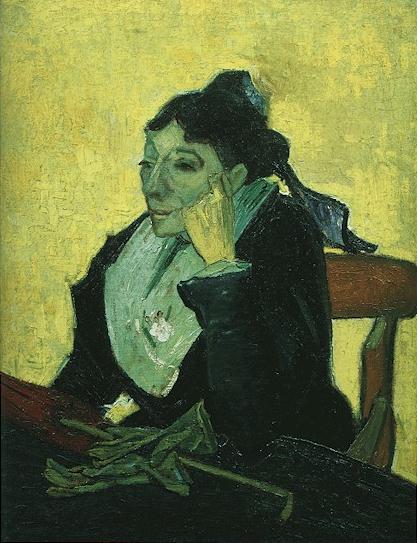 The Arlésienne (1888, Musée d’Orsay, Paris), Fishing Boats on the Beach at Les SaintesMaries-de-la-Mer (1888, Van Gogh Museum, Amsterdam/Vincent van Gogh Foundation)  or The Stevedores in Arles (1888, Museo Nacional ThyssenBornemisza). By the First World War, nearly 120 presentations all over the country had featured works by Van Gogh. These activities culminated in the Sonderbund exhibition in Cologne in 1912, where the first five rooms were devoted to Van Gogh and in which more than 125 works were on display. Van Gogh in German Museums The increasing presence of works by Van Gogh in exhibitions also had an impact on the acquisition policy of German museums. On an international level, these were among the first institutions to buy works by the Dutchman, long before this occurred in France, England and the United States. The Museum Folkwang in Hagen (later in Essen), which was founded by the private collector Ernst Osthaus, broke the first ground. Museums in Bremen, Dresden, Frankfurt, Cologne, Magdeburg, Mannheim, Munich and Szczecin followed. The Städel exhibition brings together representative examples of early acquisitions, including /135%20%20Portrait%20of%20Armand%20Roulin.jpg) Van Gogh’s Portrait of Armand Roulin (1888, Museum Folkwang, Essen), 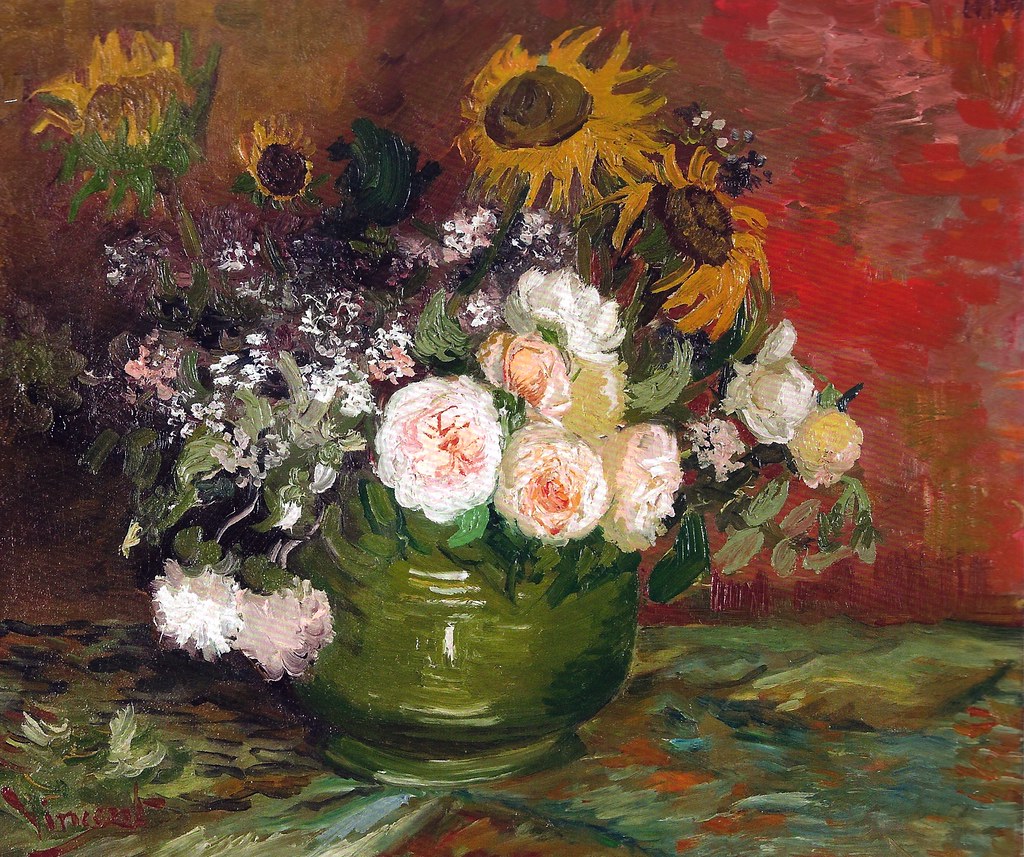 Roses and Sunflowers (1886, Kunsthalle Mannheim),  View of Arles (1889, Bayerische Staatsgemäldesammlungen – Neue Pinakothek München)  and Still Life with Quinces (1887/88, Albertinum / Galerie Neue Meister, Staatliche Kunstsammlungen Dresden). In conservative circles, critical voices against this development were raised early on. In 1911, the Worpswede landscape painter Carl Vinnen initiated a protest pamphlet opposing the acquisition of a Van Gogh painting for the Kunsthalle Bremen. A total of 123 artists criticised the perceived dominant position of French Impressionism in German museum collections and the waste of tax money. Numerous artist, museum directors and critics defended the purchase in a response publication and placed emphasis on the importance of a contemporary international orientation of the acquisition policy of German museums. Van Gogh at the Städel The first purchase of a Van Gogh painting by a publicly funded museum was made in 1908. With the support of the Städelscher Museums-Verein, the director of the Städel, Georg Swarzenski, acquired the painting Farmhouse in Nuenen (1885) as well as the drawing Peasant Woman Planting Potatoes (1885) for the collection of modern art. This was followed in 1911 by the purchase of the principal work Portrait of Dr Gachet (1890), which became the museum’s showpiece. This last portrait painted by Van Gogh marked the interface between art of the nineteenth century and classic modernism. The National Socialists confiscated the painting in 1937 and sold it on the international art market in exchange for foreign currency. The Städel exhibition presents the empty picture frame, which continues to be in the museum’s depot to this day – the painting itself is part of a private collection and not accessible to the public. On the occasion of the exhibition, the Städel has produced a five-part podcast that traces the turbulent history of the painting. Van Gogh Collectors in Germany Vincent van Gogh’s popularity in Germany is reflected in the large number of private collectors who were already buying his art at an early date. The most important protagonists include Thea and Carl Sternheim, Adolf Rothermund, Paul von Mendelssohn-Bartholdy and Harry Graf Kessler as well as Willy Gretor and Maria Slavona. Several art dealers, such as Alfred Flechtheim and Paul Cassirer, also acquired works for their collections. The exhibition features artworks by Van Gogh that formerly belonged to German collections, such as  Farmhouse in Provence (1888, National Gallery of Art, Washington, D.C.), 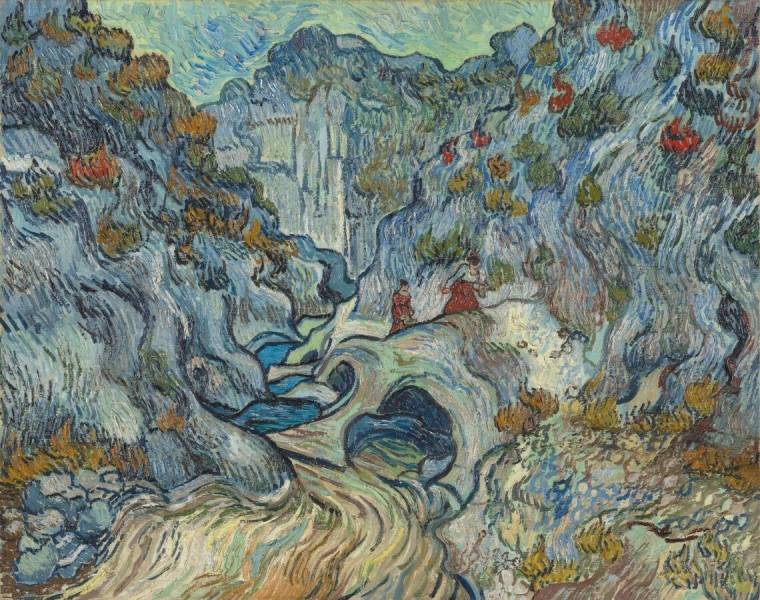 The Ravine(Les Peiroulets) (1889, Kröller-Müller Museum, Otterlo) 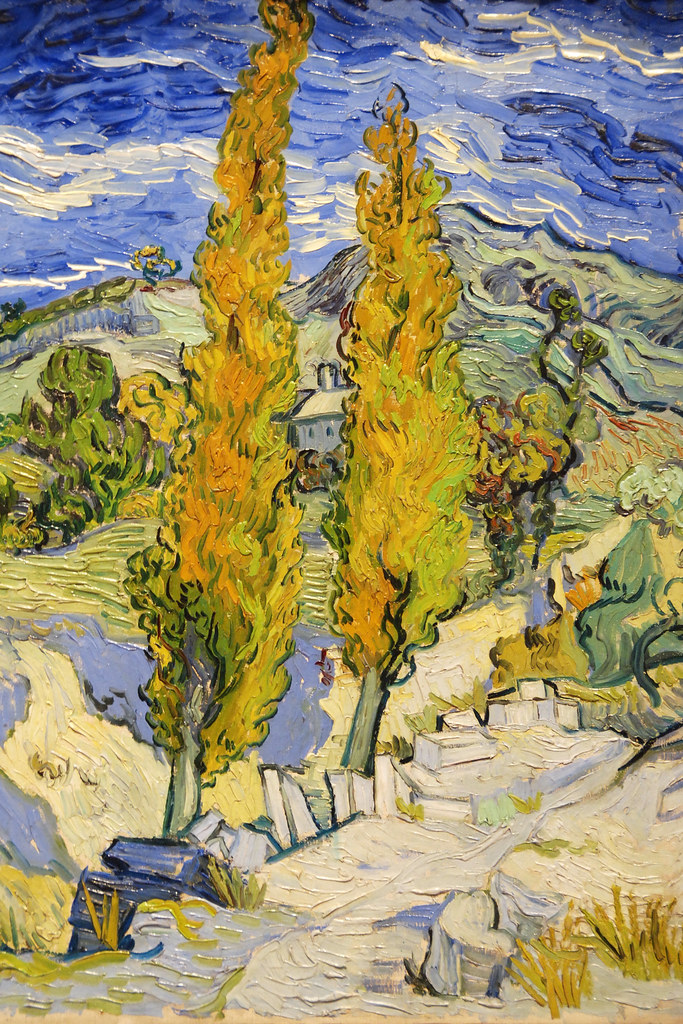 or The Poplars at Saint-Rémy (1889, The Cleveland Museum of Art). A large proportion of the private collectors came from the educated Jewish middle class, which established modern art in Germany. The inflation of the 1920s, the Great Depression and the persecution and murder of Jewish citizens during the period of National Socialism resulted in a drastic reduction in the number of works by Van Gogh in private German collections, so that today only a handful remain. From Artist to Literary Hero: Julius Meier-Graefe Prior to the First World War, Van Gogh became a popular topic of conversation among German collectors. The writings of Julius Meier-Graefe made a crucial contribution to this development. The art critic and gallery owner had lived in Paris in the 1890s and noticed how French and Dutch authors turned Van Gogh into an “art apostle” after his death who, following Jesus Christ, lived and suffered for his painting. Meier-Graefe picked up on the incipient myth-making around the artist and processed it for the German public. His three-volume Entwicklungsgeschichte der modernen Kunst (History of the Development of Modern Art, 1904) and the monograph Vincent van Gogh (1910) became bestsellers in Germany. Meier-Graefe gradually embellished his stories about the artist over the years. His two-volume novel Vincent was published in 1921and promoted the formation of the legend around the artist. Forgeries The fact that Van Gogh was one of the most popular artists in Germany before 1914 is also demonstrated by the forgeries that circulated on the art market. The approximately 30 Van Gogh forgeries put into circulation in the 1920s by the gallery owner Otto Wacker resulted in the first art forgery lawsuit in Germany. Numerous experts were also involved. The trial ended with Otto Wacker being sentenced to several years in prison. However, not all forgeries were intended as such, as can be illustrated by the copy of a famous self-portrait by Van Gogh. The painting being presented in the exhibition was created by the young French painter Judith Gérard in 1897. Shortly thereafter, it found its way onto the art market without her knowledge and was sold as a genuine Van Gogh. Her signature had been painted over with a floral decoration. It would be decades before Gérard was able to convince the world that she was the painting’s true author. CHAPTER 2: INFLUENCE The Simple Life: Peasant Motifs A large share of Van Gogh’s art addresses rural life and the arduous work of the peasants. His role model was the French painter Jean-François Millet. Van Gogh translated Millet’s motifs into his own pictorial language, whereby he lent them a chromaticity that corresponded with his personal sensitivity. Van Gogh’s paintings in turn impressed numerous artists. They orientated themselves towards him, and at the same time they tried to develop their own signature. The Städel exhibition juxtapose works by Van Gogh, such as 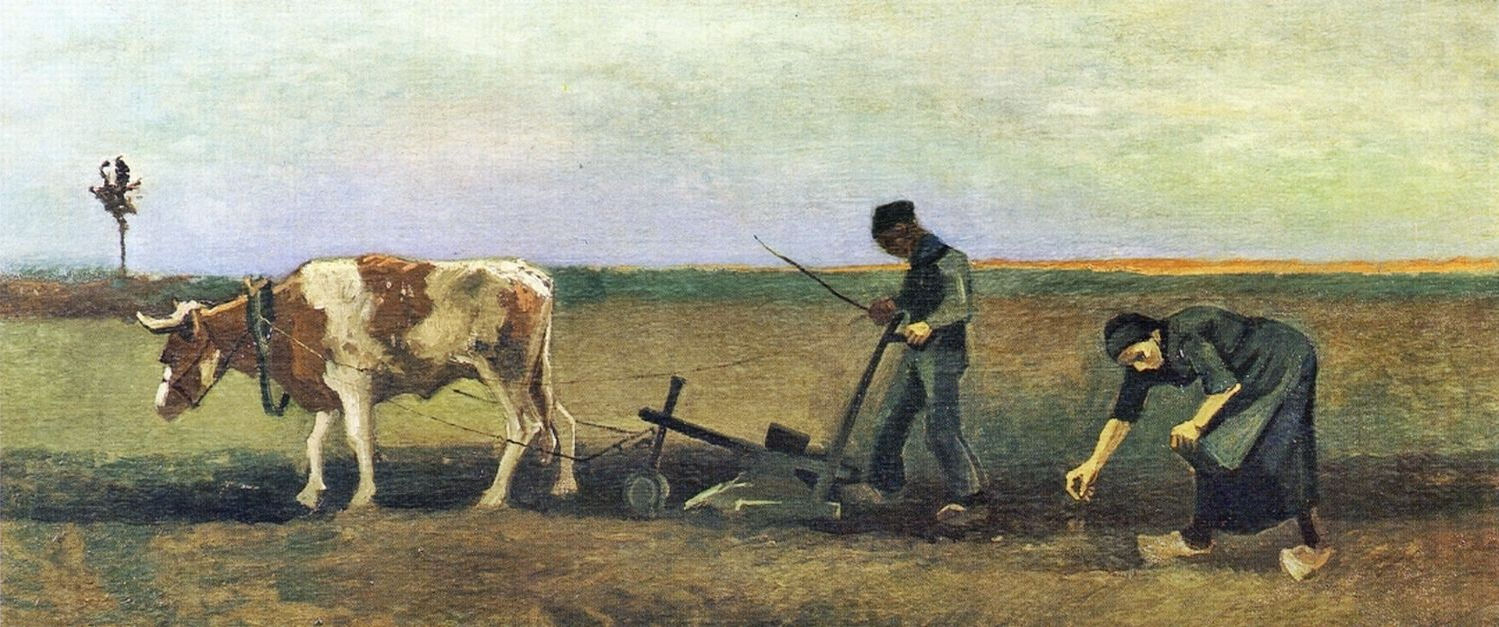 Potato Planting (1884, Von der Heydt-Museum Wuppertal),  Two Peasants Digging (1889, Stedelijk Museum Amsterdam) or the portrait Augustine Roulin (Rocking a Cradle) (1889, Stedelijk Museum Amsterdam)  with works by Paula Modersohn-Becker (Woman from the Poorhouse with Glass Globe and Poppies, 1907, Museen Böttcherstraße, Paula Modersohn-Becker Museum, Bremen),  Gabriele Münter Woman from Murnau (Rosalia Leiß), (1909, Schloßmuseum Murnau) or Heinrich Nauen (Peasant Digging, 1908, Galerie Ludorff, Düsseldorf). Self-Portraits The self-portraits by Van Gogh motivated younger artists to depict themselves in a similar manner. Van Gogh was regarded as a ‘tragic hero’, as a suffering artist who was misunderstood by society and had sacrificed himself for his art. This image strongly appealed to male artists in particular. The exhibition demonstrates this by self-portraits by Cuno Amiet (c.1907), Max Beckmann (1905), Peter August Böckstiegel (1913), Ludwig Meidner (1919) or Heinrich Nauen (1909), among others. Drawings and Reproductions Van Gogh’s oeuvre consists in large part of drawings. At the beginning of his career, the artist trained primarily by copying original works before venturing his own motifs. In later years, his drawings came to be more closely linked to his painting. They served to prepare a composition or to repeat and condense a motif he had found in a painting. Because there were only limited possibilities available to reproduce works in colour in the early twentieth century, initially it was primarily Van Gogh’s drawings that were illustrated in publications. Their graphically clear structure was particularly well suited for being transferred into line blocks (etchings) and reproduced. Drawings by Van Gogh that appeared in magazines and books supplied German artists with their first illustrative material and inspired them to make their own attempts. In the Städel exhibition, two rooms present a selection of Van Gogh’s drawings, including masterpieces such as  Haystacks (1888, Museum of Fine Arts, Budapest)  and Farmhouse in Provence (1888, Rijksmuseum, Amsterdam). Just how differently the German Expressionists reacted to Van Gogh’s vital drawing technique is illustrated in the works by, for example, Fritz Bleyl, Paul Klee, Ernst Ludwig Kirchner, Wilhelm Morgner and Max Pechstein. “Van Goghiana” The members of the ‘Die Brücke’ in Dresden dealt with Van Gogh in a particularly vigorous way. They saw works by the artist in an exhibition in Dresden in 1905. For the young students of architecture Ernst Ludwig Kirchner, Erich Heckel and Karl Schmidt-Rottluff, this experience was at once a revelation and also liberation. Van Gogh’s paintings prompted them to apply paint to the canvas directly out of the tube. From then on, strong contrasts, impasto layers of paint and simplified forms defined their works. In doing so, they wanted to emphasize their direct and unadulterated access to the motif, which no longer orientated itself towards the standards of academic painting. The fascination with Van Gogh was in part so pronounced that Emil Nolde recommended that his colleagues call themselves “Van Goghiana” instead. However, the artistic reaction of the members of the ‘Die Brücke’ was in some cases highly diverse.
While the academically trained painters Max Pechstein and Cuno
Amiet scrutinized Van Gogh’s painting and imitated his systematically
placed brushstrokes, Erich Heckel and Karl Schmidt-Rottluff dealt with
him more freely.
These various approaches are presented in the Städel exhibition, including Ernst Ludwig Kirchner’s Fehmarn Houses (1908, Städel Museum, Frankfurt am Main) 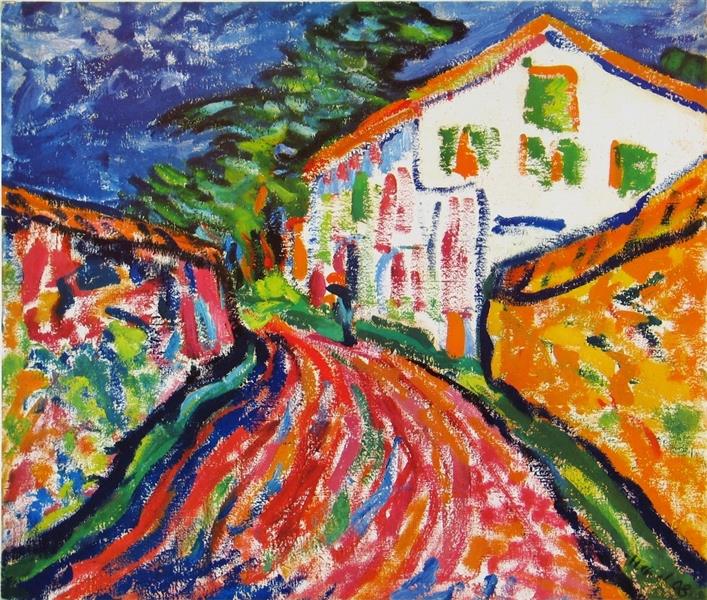 or Erich Heckel’s House in Dangast (The White House) (1908, Carmen ThyssenBornemisza Collection, on loan to the Museo Nacional Thyssen-Bornemisza, Madrid). CHAPTER 3: PAINTING STYLE Stylistic Pluralism The third chapter of the exhibition deals with Van Gogh’s distinct painting style. In his short productive period, which encompasses no more than a decade, the artist worked in an extraordinary range of styles. Beginning in the second half of the 1880s, he experimented, in part simultaneously, with the various painting styles of Realism, Impressionism, Pointillism, Cloisonism or Symbolism. These are only some of the kaleidoscope of modern art movements that Van Gogh encountered after his arrival in Paris in 1886.
For Van Gogh, the fundamental
question was whether his paintings should be planar and form-bound or
vibrantly structured and dynamic. He sought his own path between the
two. The exhibition presents works by Van Gogh that illustrate this
versatility, including, for example,

Le Blute-Fin Mill (1886, Museum de
Fundatie, Zwolle and Heino/Wijhe, the Netherlands),
Square Saint-Pierre, Paris (1887, Yale University Art Gallery, New Haven), Piles of French Novels (1887, Van Gogh Museum, Amsterdam/Vincent van Gogh Foundation) or  Poppy Field (1890, Kunstmuseum Den Haag). Structure and surface, rhythm and stasis, impasto and smooth surfaces, subdued coloration and strong colour contrasts encounter one another in Van Gogh’s oeuvre and are coequal means of organizing a painting that are in part used simultaneously. Surface Subsequent generations of artists made reference to various aspects of Van Gogh’s painting. Those artists in Germany who aimed for a calm pictorial structure while simultaneously enhancing colour, trained themselves based on his planar compositions. The exhibition features works by, among others, Gabriele Münter (Alley in front of a mountain, 1909, private collection), 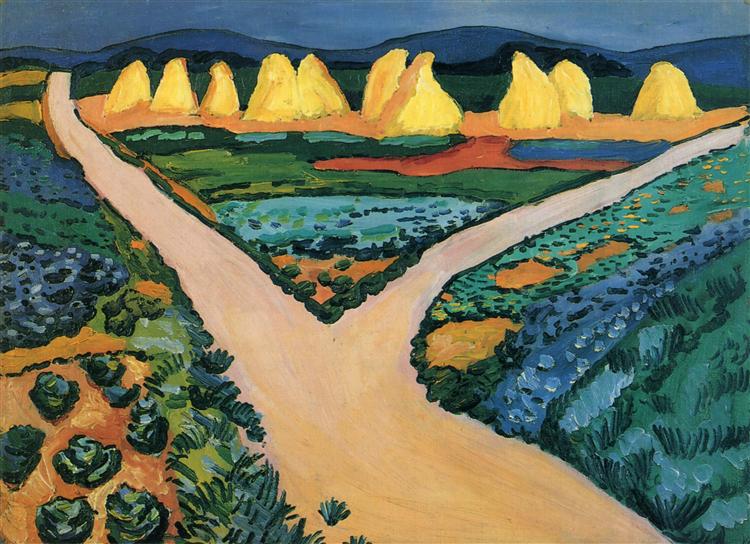 August Macke (Vegetable Fields, 1911, Kunstmuseum Bonn)
and Felix Nussbaum (Arles sur Rhône Avenue of Tombs,
Les Alyscamps, 1929,
Felix-Nussbaum-Haus, Osnabrück)

as well as the
painting Flowers (1908, private collection) by the largely forgotten
painter Elsa Tischner-von Durant.
With Josef Scharl’s Still Life with Candle and Books (1929, Sammlung Henry Nold), the exhibition takes a look at the changed reception of Van Gogh in Germany after the First World War. His emotionalism and expressivity were replaced by an increasingly modest pictorial language. Rhythm and Structure In the last years of his life, Van Gogh’s impasto style of painting was accompanied by a rhythmical structuring of his works. At the same time, the markedly directional line strokes bordered on ornamental design. The brushwork became an autonomous means of expression and forced the descriptive function of painting into the background. Kurt Badt, who saw a kind of “painting draughtsman” in Van Gogh, described this phenomenon as “expressive linearity taking on with a life of its own”.
Line and colour no longer opposed each other as artistic means,
but were connected with one another. One room in the Städel exhibition
presents a series of examples for how artists made reference to Van
Gogh’s style of painting that brought together vitality and structure.
These include members of the artists’ groups ‘Die Brücke’ or ‘Der Blaue
Reiter’ as well as singular positions such as Christian Rohlfs and Max
Beckmann.
Furthermore, with the painter Theo von Brockhusen, who has
been largely forgotten today, the Städel is presenting an artist that
closely followed Van Gogh’s example in terms of motif and style. His
adoption of the latter’s specific brushstroke earned him the nickname
“von Goghhusen”.
“Painter of the Sun” Van Gogh also made an impression on the German Expressionists with paintings in which the sun stands on the horizon as a blazing fixed star. These depictions were unusual in so far as painters had previously reproduced sunlight for the most part indirectly. By contrast, Van Gogh shifted the sun as a life-giving and hopeful symbol into the centre of his compositions, for instance in  Willows at Sunset (1888, KröllerMüller Museum, Otterlo). Moreover, numerous representatives of Expressionism understood Van Gogh’s form of “sun painting” as an apocalyptic symbol. This interpretation, in which Julius Meier-Graefe had a decisive share, fit in with the unsettling times before the First World War; however, it also seemed plausible in the tense political situation of the Weimar Republic.
Explicit reactions to these works by Van Gogh can be found in
both phases, such as, for example,
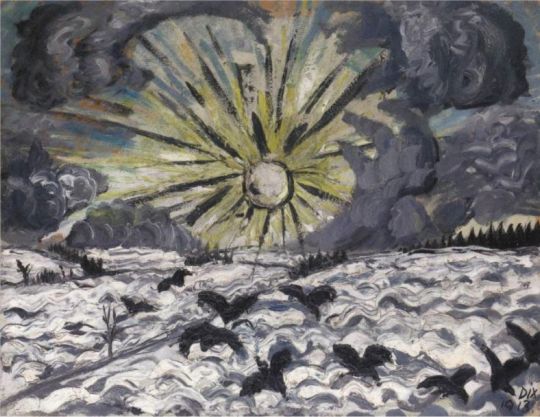 Otto Dix’s Sunrise (1913, Städtische Galerie Dresden – Kunstsammlung, Museen der Stadt Dresden), Wilhelm Morgner’s The Tree (1911, Museum Wilhelm Morgner, Soest), Walter Ophey’s River Landscape with Boats and Red Sun (1913/14, Kunstpalast, Düsseldorf), Max Pechstein’s Rising Sun (1933, Saarlandmuseum – Moderne Galerie, Saarbrücken, Stiftung Saarländischer Kulturbesitz) or Josef Scharl’s Landscape with Three Suns (1925, Kunsthalle Emden – Stiftung Henri und Eske Nannen). |